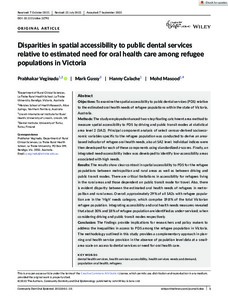Disparities in spatial accessibility to public dental services relative to estimated need for oral health care among refugee populations in Victoria
Veginadu Prabhakar; Gussy Mark; Calache Hanny; Masood Mohd
https://urn.fi/URN:NBN:fi-fe2022102463076
Tiivistelmä
Objectives
To examine the spatial accessibility to public dental services (PDS) relative to the estimated oral health needs of refugee populations within the state of Victoria, Australia.
Methods
The study employed enhanced two-step floating catchment area method to measure spatial accessibility to PDS by driving and public transit modes at statistical area level 2 (SA2). Principal component analysis of select census-derived socioeconomic variables specific to the refugee population was conducted to derive an area-based indicator of refugee oral health needs, also at SA2 level. Individual indices were then developed for each of these components using standardized z-scores. Finally, an integrated need-accessibility index was developed to identify low-accessibility areas associated with high needs.
Results
The results show clear contrast in spatial accessibility to PDS for the refugee populations between metropolitan and rural areas as well as between driving and public transit modes. There are critical limitations in accessibility for refugees living in the rural areas and those dependent on public transit mode for travel. Also, there is evident disparity between the estimated oral health needs of refugees in metropolitan and rural areas. Overall, approximately 29% of all SA2s with refugee population are in the 'High' needs category, which comprise 19.8% of the total Victorian refugee population. Integrating accessibility and oral health needs measures revealed that about 30% and 18% of refugee population are identified as under-serviced, when considering driving and public transit modes respectively.
Conclusion
The findings provide implications for researchers and policy makers to address the inequalities in access to PDS among the refugee population in Victoria. The methodology outlined in this study provides a complementary approach in planning oral health service provision in the absence of population level data at a small-area scale on access to dental services or need for oral health care.
Kokoelmat
- Rinnakkaistallenteet [27094]
